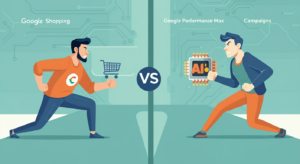Constant improvement is the name of the game here at StubGroup, and should be every advertiser’s goal.
But sometimes it feels like you hit a brick wall in your optimization efforts.
That’s why we developed this handy checklist of questions to ask when performance plateaus in a Google Ads account.
1. Can we increase the budget to capture more Impression Share?
This is one of the most obvious questions to ask, but is missed surprisingly often when we audit accounts for businesses who want to hire us.
Check out the column named “Search Lost IS (budget)” in the Google Ads interface to see the percentage of traffic that Google reports you missed because your daily budget wasn’t high enough to capture all available searches that could have matched to your keywords.
Should you increase your budget if you’re losing Impression Share due to a limited budget? That depends. Are your campaigns currently profitable? If so, then you most likely should spend more. If you’re not profitable, you probably need to address that before spending more money on ads.
2. Can we increase bids/target values to get a higher ad position and more traffic?
Google Ads operates as an auction, and if you’re not bidding competitively, you may be losing auctions or getting bottom-of-page real estate.
Google has a variety of ways to indicate within the Google Ads interface whether your bids are a limiting factor.
“Search Lost IS (rank)” is a metric that tells you what percentage of searches your ads did not appear for because your Ad Rank was too low. Now, Ad Rank is determined by a variety of factors in addition to bid, but your bid is an important factor in Ad Rank, so if you’re losing a lot of Impression Share due to low Ad Rank, it may be a sign that you’re not bidding competitively.
If you’re using an automated bidding strategy such as Maximize Conversions with Target CPA or Maximize Value with Target ROAS, Google will generally tell you whether your targets are limiting how often your ads can serve.
Losing Impression Share due to low Ad Rank doesn’t inherently mean you need to get more aggressive with your bids or targets, because profitability is still key. There is always going to be traffic you can’t afford to pay for because it doesn’t convert at a high enough rate to increase your bottom line. But it’s always a metric you should be looking at.
3. Can we target new keywords?
The days of massive keyword lists are long gone as Google pushes Broad Match keywords and Performance Max campaigns.
But, there is still very much a place for creative keyword research and identifying ideas that Google’s automated systems may not realize are relevant.
Where do you find these ideas?
- Use third-party tools such as SpyFu or SEMRush to see what keywords competitors are targeting
- Read your landing page and competitor landing pages to find phrases you’re not already using in your Google Ads account
- Use Google’s auto-suggest and “Related searches” features to see related words people are using
- Read news articles about the products/services you and your competitors sell to see how journalists and the people they interview describe what you do
4. Can we add Broad Match keywords?
The Broad Match keyword match type was once anathema to many paid search specialists, and with good reason. It was generally the easiest way to waste ad spend and get your ads appearing in front of a wide variety of irrelevant searches matched by Google to your keywords.
However, Google has made significant strides in improving their ability to match Broad Match keywords to relevant search terms and also learn quickly from conversion tracking to identify what is relevant to your particular campaigns.
That doesn’t mean that Broad Match keywords are right for every situation, and you should absolutely use caution when leveraging them.
But, in the right context, we have seen great results from Broad Match keywords and view them as an important tool in our testing arsenal.
5. Can we run a Pay for Conversion campaign on Google Display?
Some Google Ads accounts are eligible for “Pay for Conversion” campaigns, which allows you to run ads on Google’s Display Network and only pay when people clicking those ads actually convert through your website.
While not available for every advertiser, this can be a great tool to mitigate your risk while increasing your exposure to new customers via Google Display.
See more information and eligibility requirements here.
6. Can we move to an automated bidding strategy?
If you have been running campaigns via Google Ads for a while, chances are that you might still be using Manual CPC bidding, which means you’re telling Google the maximum amount you are willing to pay per click.
We have been able to drive dramatic results for many of our clients by upgrading their bidding approach to automated bidding strategies such as Maximize Conversions with Target CPA and Maximize Value with Target ROAS.
By giving Google the flexibility to be more aggressive with traffic that is likely to convert and filter out traffic that is not likely to convert, you can both cut wasted ad spend and scale campaigns.
There is an exception to every rule, and automated bidding is not right for every account, but for many Google Ads accounts, switching away from Manual CPC bidding is like stepping out of the Stone Ages.
7. Can we test new landing pages?
We’ve all seen it and, let’s be honest, we’ve probably done it, too.
We funnel thousands of dollars into Google Ads campaigns that send traffic to stale, mediocre landing pages.
We expect people to figure out what we want them to do on our website, instead of making it painfully obvious exactly what course of action we want them to take and resolving every obstacle in their way.
Better-converting landing pages can turn so-so campaigns into heroes, and they can turn categories of traffic that historically were too expensive to target into your next cash cow campaign.
8. Can we run ads on Microsoft Advertising?
Microsoft Advertising (formerly called Bing Ads) gives you access to the Microsoft Bing search engine as well as Yahoo!, DuckDuckGo, and other partner search engines.
While you won’t find nearly as much traffic on Microsoft Bing as you will on Google, there is still enough to move the needle with your campaigns and it’s often well worth the energy to port your Google campaigns to Microsoft’s platform and pick up traffic you wouldn’t otherwise receive.
9. Can we run Facebook/Instagram Ads?
Many businesses take the following advertising approach: Start with Google Search and Shopping ads to capture low-hanging fruit, and then scale to YouTube, Google Display, and Facebook/Instagram.
Facebook and Instagram require a very different approach than Google Search Ads because you are reaching your audience in a different context and stage in the buying funnel.
If you’re already capturing everyone who is actively searching for the product/service you sell on Google and Microsoft Bing, then to grow you’re going to need to find customers who aren’t actively looking for you. The Facebook and Instagram platforms are a great place to go find those people and make those connections.
10. Can we run Amazon Ads?
If you’re selling a physical product, you should seriously consider whether to make that product available for sale through Amazon.
Studies show that as many as 74% of consumers start their product searches on Amazon, meaning that you’re missing a massive audience by not having your product on that platform.
Granted, there are many considerations that go into taking that step, including factoring Amazon’s fees into your cost of business, losing valuable access directly to your customers, and more.
But if you are selling products on Amazon, Amazon’s advertising program can be a great way to drive those sales up by featuring your products in front of people searching Amazon and on related product pages.
Don’t Accept Mediocrity
Always be testing, auditing, and pushing to see how you can improve your advertising, find new customers, trim waste, and increase your bottom line.




